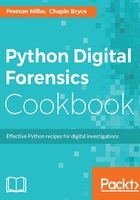
Preface
At the outset of this book, we strove to demonstrate a nearly endless corpus of use cases for Python in today’s digital investigations. Technology plays an increasingly large role in our daily life and shows no signs of stopping. Now, more than ever, it is paramount that an investigator develop programming expertise to work with increasingly large datasets. By leveraging the Python recipes explored throughout this book, we make the complex simple, efficiently extracting relevant information from large data sets. You will explore, develop, and deploy Python code and libraries to provide meaningful results that can be immediately applied to your investigations.
Throughout the book, recipes include topics such as working with forensic evidence containers, parsing mobile and desktop operating system artifacts, extracting embedded metadata from documents and executables, and identifying indicators of compromise. You will also learn how to integrate scripts with Application Program Interfaces (APIs) such as VirusTotal and PassiveTotal, and tools, such as Axiom, Cellebrite, and EnCase. By the end of the book, you will have a sound understanding of Python and will know how you can use it to process artifacts in your investigations.